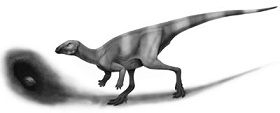
Oryctodromeus is a genus of Dinosaur that belongs to the group of small ornithopod dinosaurs. This remarkable dinosaur is known for its unique burrowing behavior, which sets it apart from many other known dinosaur species. Oryctodromeus has captured the attention of paleontologists due to its intriguing lifestyle and the insights it offers into the ecological diversity of dinosaurs during the Late Cretaceous period.
The name Oryctodromeus is derived from Greek words, with oryktos meaning digger and dromeus meaning runner, emphasizing its burrowing and agile capabilities. The specific species is named Oryctodromeus cubicularis, with cubicularis referring to its burrowing lifestyle.
| Name: | Oryctodromeus dinosaurs |
| Size: | Around 6 to 10 feet (2 to 3 meters) |
| Main Facts: | Oryctodromeus Small burrowing herbivorous dinosaur from the Late Cretaceous, known for its unique behavior, found in North America. |
Oryctodromeus lived approximately 95 to 100 million years ago, during the Late Cretaceous period. It was a time of diverse ecosystems, and dinosaurs were flourishing across the Earth. The discovery of Oryctodromeus fossils has provided valuable information about the adaptations and behaviors of these ancient creatures.

Oryctodromeus was a small herbivorous dinosaur with a length of about 6 to 10 feet (2 to 3 meters). It had a bipedal stance, walking on its hind legs, and its forelimbs were equipped with robust claws suited for digging burrows. The most distinctive feature of Oryctodromeus was its burrowing behavior, which is rare among dinosaurs.
The burrows it created measured approximately 6.5 feet (2 meters) in length and 3 feet (1 meter) in diameter, likely providing shelter and protection. Its beak-like snout indicated a herbivorous diet, similar to other ornithopods, and it lived during the Late Cretaceous period, around 95 to 100 million years ago.
Oryctodromeus is best known for its unique burrowing behavior, a behavior rarely observed among dinosaurs. Fossil evidence indicates that it was capable of digging burrows in the ground, likely for shelter and protection. This behavior suggests that Oryctodromeus may have lived in social groups or herds, as the excavation of burrows would require coordination and cooperation.
Its ability to create burrows showcases the adaptability and complexity of behaviors among dinosaurs. Additionally, being a small herbivorous dinosaur, Oryctodromeus likely fed on vegetation and lived in a Late Cretaceous environment characterized by diverse ecosystems.
Oryctodromeus is a remarkable dinosaur known for its unique burrowing behavior, distinguishing it from many other known species. This small ornithopod dinosaur lived during the Late Cretaceous period, approximately 95 to 100 million years ago. Fossil evidence indicates that Oryctodromeus was capable of digging burrows, measuring about 6.5 feet (2 meters) in length and 3 feet (1 meter) in diameter, which likely provided shelter and protection.
Its skeletal features, including powerful forelimbs and robust claws, suggest adaptation for digging. As a bipedal herbivore, Oryctodromeus likely fed on vegetation available during its time. The discovery of Oryctodromeus has expanded our understanding of dinosaur behaviors and habitats, offering valuable insights into the complexity and adaptability of prehistoric life during the Late Cretaceous.
Oryctodromeus is one of the few known burrowing dinosaurs, distinguishing it from most other dinosaur groups.
Oryctodromeus was relatively small compared to some other ornithopods and dinosaurs in general.
Its burrowing lifestyle indicates a specialized adaptation and may suggest unique ecological interactions within its Late Cretaceous environment.
Like other ornithopods, Oryctodromeus likely had a herbivorous diet, consuming plants and vegetation.